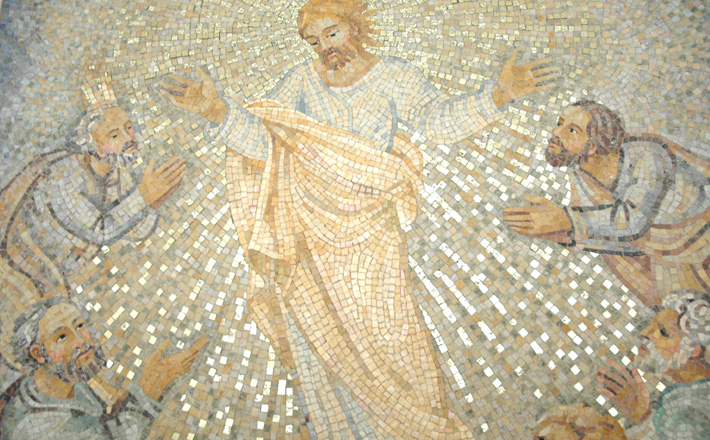Commentary on Matthew 17:1-9
At the transfiguration Jesus’ fearful disciples watch as he is transformed and shines with heavenly glory.
But what relationship can there be between Jesus’ transfigured glory revealed on this mountain and the suffering he will endure on Golgotha? And what does it mean for the disciples to follow such a leader?
The transfiguration marks the midpoint in a series of scenes that define who Jesus is. At both his baptism and transfiguration the heavenly voice announces that he is God’s son. At his temptation, in Gethsemane, and at his crucifixion, Jesus wrestles with the humiliation, suffering, and abandonment that he, as Son of God, must endure. Finally the resurrected Jesus claims his identity, sending his disciples out to teach and baptize in the name of the Father, the Son, and the Holy Spirit.
In the scenes leading up to the transfiguration, the disciples worship the Jesus who walks on water as the Son of God (Matthew 14:33), but they cannot yet imagine what it means for Jesus to claim this title. Although Peter identifies Jesus as the Messiah, the Son of the living God, he utterly rejects Jesus’ announcement that he will suffer and die. Jesus affirms Peter’s insight but rejects his protest, calling him Satan for tempting the Son of God to define himself by glory but not by suffering. Furthermore, he calls Peter and anyone else who wants to be his disciple to follow him on the road that leads to the cross.
Six days later, Jesus takes Peter, James, and John up onto a high mountain. There he is transformed before them. His face shines like the sun, and his clothes become white as light (descriptions unique to Matthew). Moses and Elijah appear and talk to Jesus. As in Mark and Luke, Peter says, “It is good for us to be here,” and suggests building tents for each of the three, but Matthew treats Peter differently here than the other Gospels do: Peter calls Jesus “Lord,” the title that in Matthew indicates faith; he defers to Jesus’ will (“if you wish”); he offers to undertake the construction of tents there alone (“I will build here,” vs. “let us build” in Mark and Luke); and there is no indication at this point that he is afraid or does not know what he is saying (cf. Mark 9:6, Luke 9:33).
Jesus does not respond to the offer, but while Peter is still speaking, a brilliant cloud overshadows them. A voice from the cloud in Matthew 17 echoes the words of the heavenly voice at Jesus’ baptism: “This is my Son, the Beloved, with whom I am well pleased” (NRSV translates Matthew 17:5 and Matthew 3:17 slightly differently, but the wording is identical in Greek). Then the voice adds a command: “listen to him!” At the sound of God’s voice, the disciples collapse in terror.
The whole scene resonates with allusions to the Old Testament. It recalls Elijah’s encounter with God on the holy mountain. It brings to mind the revelation at Mt. Sinai and the cloud of God’s glory overshadowing both the mountain and the tent where Moses met with God. And it evokes Malachi 4, in which God commands the people to remember Moses’ words and says that Elijah will be sent on a mission of restoration before the day of the LORD.
It is no wonder that the disciples are terrified by this theophany. As Malachi says, “Who can endure the day of his coming, and who can stand when he appears?” (Malachi 3:2). Then Jesus approaches his frightened followers, touches them, and tells them not to be afraid. Though they cannot bear to hear God speak from the cloud, they can listen to Jesus. The word of God comes to them now, not as a thunderous voice from heaven or letters written on tablets of stone, but in the words and actions of Jesus. The Son of God speaks to them as one human speaks to another, and they rise and follow him.
On the way down the mountain Jesus tells them once again that the Son of Man must suffer, and he orders them to tell no one about the vision until after he has been raised from the dead. They discuss Elijah’s role in restoring all things, and then Jesus, whose face has shone like the sun, descends into the needy human crowd and immediately heals a demon-possessed child. As Malachi says, “For you who revere my name the sun of righteousness shall rise with healing in its wings” (Malachi 4:2).
The story of the transfiguration directs us away from trying to understand Jesus only as he is revealed in glory. It points us down the mountain and invites us to walk with Jesus into the suffering, hungry crowds. The divine voice commands us to listen to Jesus. But listening is more than hearing. As Jesus says in the Sermon on the Mount, building on the rock means not only hearing his words, but acting on them (Matthew 7:24). Hearing without obeying leads to catastrophe.
At Gethsemane, when Jesus himself faces the temptation to disobey his Father and abandon the road to the cross, the same three disciples who saw him transfigured wait with him while he grieves and prays. He passes the test, but they do not. He walks steadfastly on to suffering and death, and they desert him and flee. On the cross Jesus shows the world the obedient Son of God in all his suffering humanity, pouring out his blood for the forgiveness of sins. After the resurrection the Son of God appears to the disciples with all his divine authority, calling them to baptize and to teach people to obey his commands. Then he sends them down the mountain and into the world he loves, promising them that he will be with them always. We too are sent; we too must listen and obey. And the promise of his presence is ours as well.


March 2, 2014